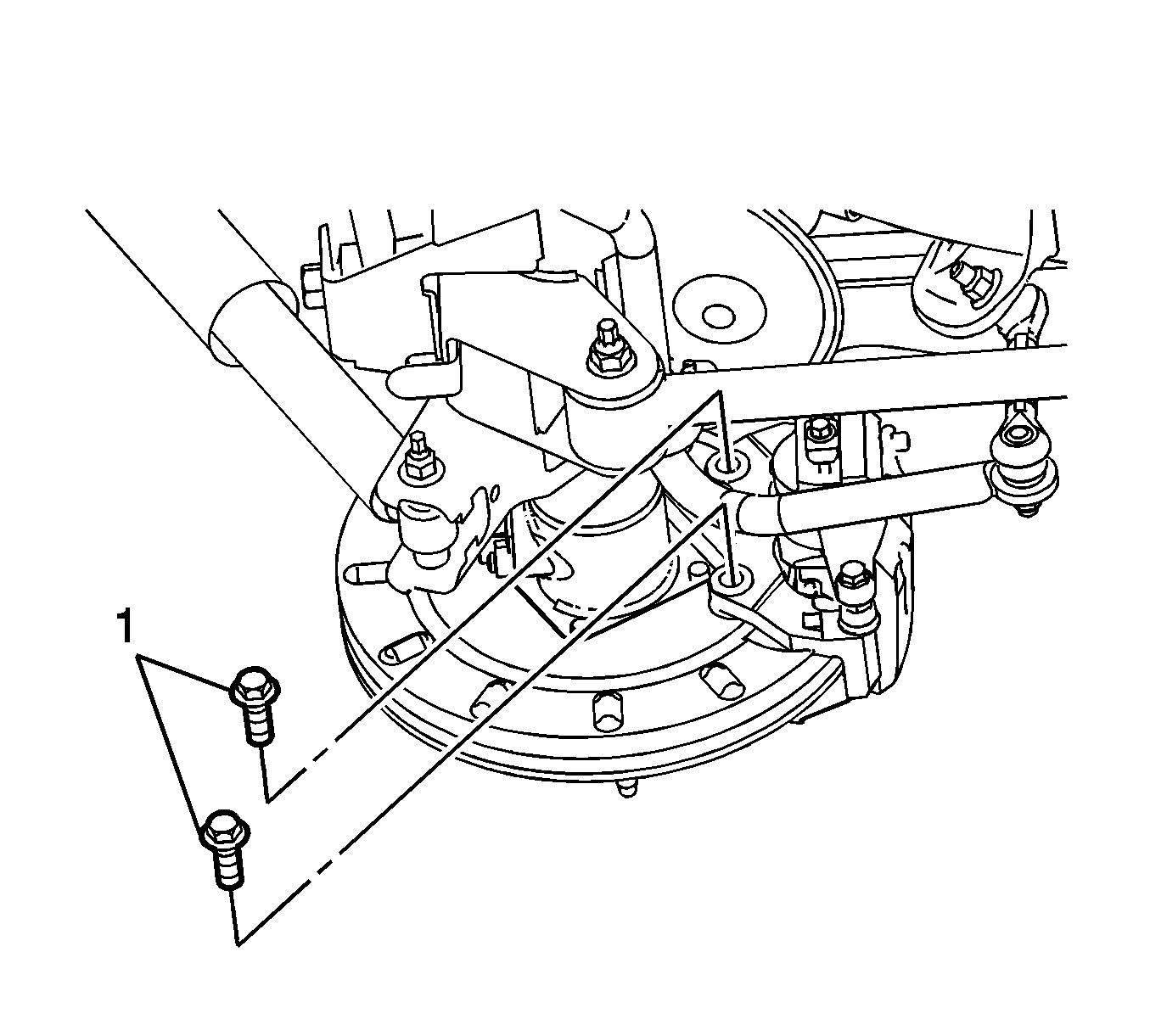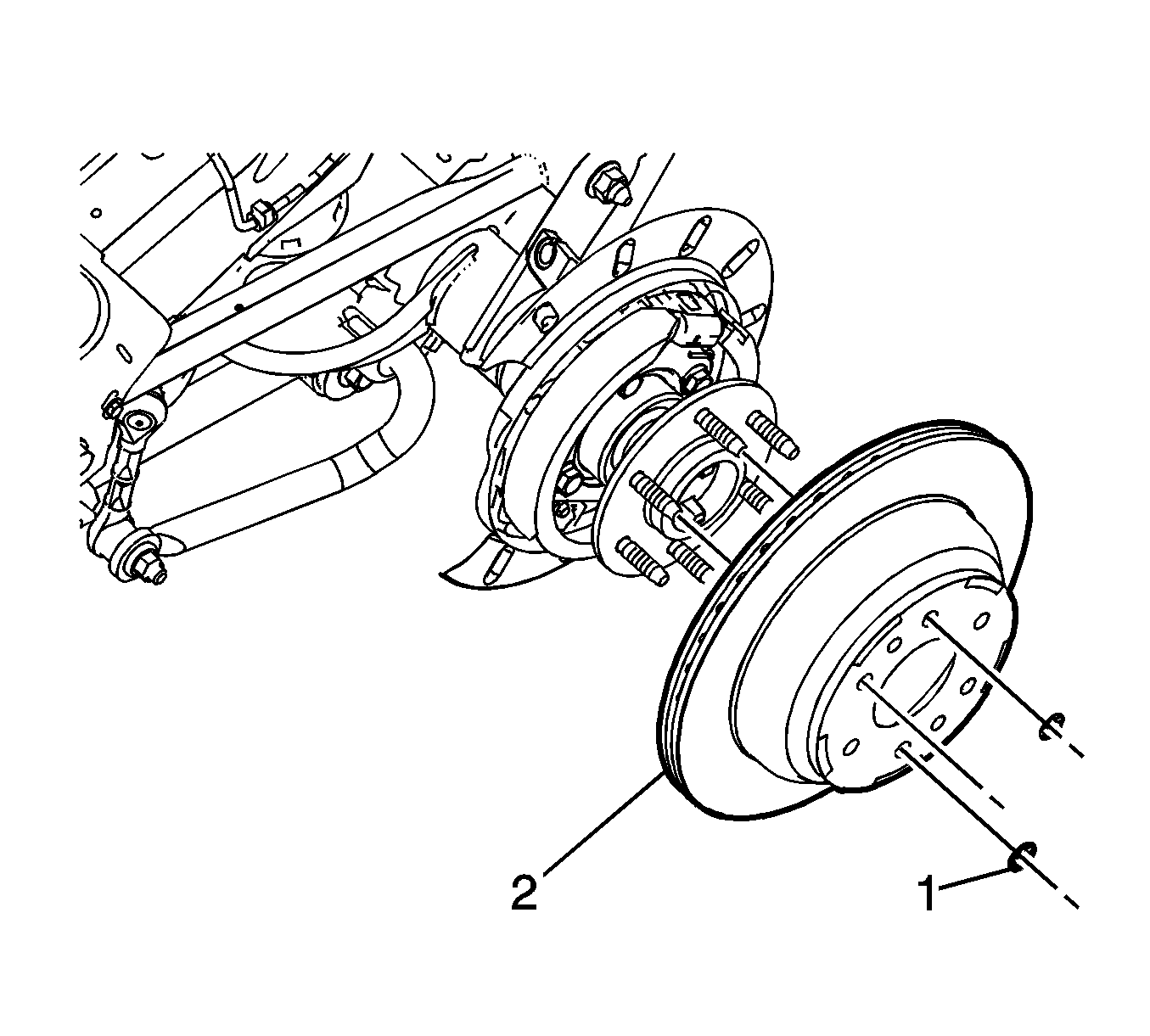Special Tools
| • | J-41013 Rotor Resurfacing Kit |
| • | J-42450-A Wheel Hub Resurfacing Kit |
Removal Procedure
Warning: Refer to Brake Dust Warning in the Preface section.
- Inspect the fluid level in the brake master cylinder reservoir.
- If the brake fluid level is midway between the maximum-full point and the minimum allowable level, no brake fluid needs to be removed from the reservoir before proceeding.
- If the brake fluid level is higher than midway between the maximum-full point and the minimum allowable level, remove brake fluid to the midway point before proceeding.
- Raise and support the vehicle. Refer to Lifting and Jacking the Vehicle.
- Remove the tire and wheel assembly. Refer to Tire and Wheel Removal and Installation.
- If installing the original brake rotor, mark the relationship of the brake rotor to the hub.
- Remove the brake caliper bracket bolts (1).
- Without disconnecting the brake caliper hose, remove the brake caliper and bracket assembly (1) and support with heavy mechanics wire or equivalent.
- Remove the 2 brake rotor retainers (1) and the brake rotor (2).

Caution: Support the brake caliper with heavy mechanic wire, or equivalent, whenever it is separated from its mount and the hydraulic flexible brake hose is still connected. Failure to support the caliper in this manner will cause the flexible brake hose to bear the weight of the caliper, which may cause damage to the brake hose and in turn may cause a brake fluid leak.


Discard the brake rotor retainers.
Installation Procedure
Note: Whenever the brake rotor has been separated from the hub/axle flange, any rust or contaminants should be cleaned from the hub/axle flange to brake rotor mating surface. Failure to do this may result in excessive assembled lateral runout (LRO) of the brake rotor, which could lead to brake pulsation.
- If installing a new brake rotor, clean the friction surfaces of the brake rotor with denatured alcohol.
- Using the J-42450-A Wheel Hub Resurfacing Kit , thoroughly clean any rust or corrosion from the mating surface of the hub/axle flange.
- Using the J-41013 Rotor Resurfacing Kit , thoroughly clean any rust or corrosion from the mating surface of the rotor to the hub/axle flange.
- Inspect the mating surfaces of the hub/axle flange and the rotor to ensure there are no foreign particles or debris remaining.
- Install the brake rotor (1) to the wheel hub.
- If the brake rotor was removed and installed as part of a brake system repair, measure the assembled lateral runout (LRO) of the brake rotor to ensure optimum performance of the disc brakes. Refer to Brake Rotor Assembled Lateral Runout Measurement.
- If the brake rotor assembled LRO measurement exceeds the specification, bring the LRO to within specifications. Refer to Brake Rotor Assembled Lateral Runout Correction
- Install the brake caliper and bracket assembly (1).
- Install the brake caliper bracket bolts (1) and tighten the bolts to 200 N·m (148 lb ft).
- Install the tire and wheel assembly. Refer to Tire and Wheel Removal and Installation.
- With the engine OFF, gradually apply the brake pedal to approximately 2/3 of it's travel distance.
- Slowly release the brake pedal.
- Wait 15 seconds, then repeat steps 11-12 until a firm pedal is obtained to properly seat the brake caliper pistons and brake pads.
- Fill the master cylinder reservoir to the proper level with GM approve brake fluid from a clean sealed brake fluid container. Refer to Master Cylinder Reservoir Filling.
- Burnish the brake pads and rotors. Refer to Brake Pad and Rotor Burnishing.

If installing the original brake rotor, align the rotor to the wheel hub as noted during removal.

Caution: Refer to Fastener Caution in the Preface section.

